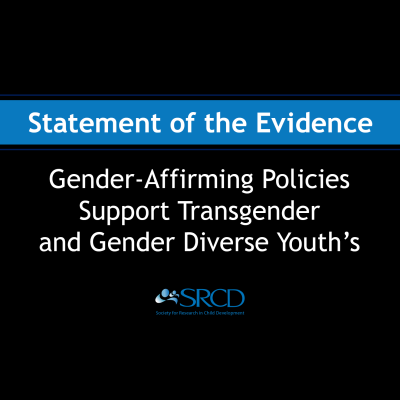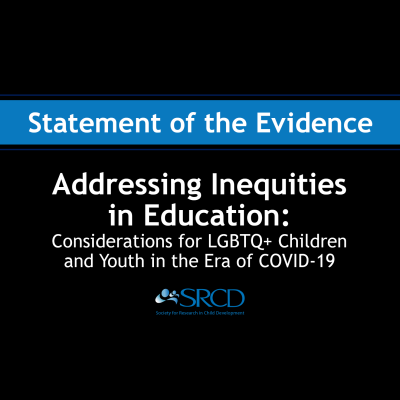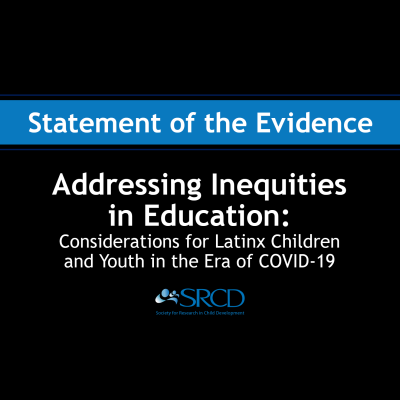Highlighting the Positive Development of Minority Children
Why Does This Matter?
In recent decades, the development and well-being of ethnic and racial minority children has received sustained attention from policymakers and practitioners. But much of the focus has emphasized problems in the children’s development, eclipsing attention to minority children’s strengths and assets. We must pay closer attention to what families and communities are doing right to promote optimal child development so these efforts can be supported and strengthened through programs and interventions.
A primary focus on adversity has had the unintended consequence of drawing attention away from the strengths and assets minority families bring to raising healthy children.
Policy and Practice Implications
Policymakers and practitioners should focus on the positive development of minority children, highlighting adaptation and adjustment rather than only maladjustment and adversity. In particular, they should:
- Recognize the variability in socioeconomic status and family structure among minority children.
- Recognize that many past efforts to describe the development of minority children have focused only on the most disadvantaged and on problems and challenges, reinforcing negative stereotypes and disregarding evidence on positive development.
- Increase support for funding and disseminating research that identifies strengths in the development of minority children and the contributions of families and communities to these strengths.
- Adopt program and policy approaches that are oriented to building strengths in minority children. Such approaches include, for example, the Bridges to High School program (an experimental field trial to promote high school completion and positive mental health among low-income Mexican American teens) and the Pathways for African American Success project (a federally funded youth development program for rural African American families).
What the Research Says
- Increasingly, research is replacing deficit models with strength-focused models, such as that of positive youth development, and with growing interest in children’s resiliency and factors that promote positive outcomes.
- The shift is due in part to awareness that many minority children do not experience adversity and that many show positive outcomes despite the prevalence of socioeconomic risk, exposure to negative stereotypes, and risks associated with being children of immigrants.
- The growing diversity and numbers of ethnic and racial minority children in the United States underscore the importance of approaches focused on strengths.
- Through family-oriented practices and cultural socialization practices, many minority children grow up in supportive, loving families with a strong sense of ethnic identity and strong social competence skills; some also speak at least two languages, with the benefits this confers.
- We should extend our understanding of the values, beliefs, and family dynamics related to raising healthy children to encompass all groups of minority families, for example, focusing further on Asian American and American Indian/Alaska Native as well as Latino and African American families.
Facts at a Glance
- The ethnic and racial mix of the U.S. population is changing. Today, for the first time in its history, half of American children under 5 are of a nonWhite racial or ethnic minority group, according to Census estimates.
- A 2011 report from the Congressional Research Service found that 28 percent of African Americans/Blacks and 25 percent of Latinos had incomes below poverty, compared to 10 percent of non-Latino Whites and 12 percent of Asians.
- Thus, children growing up in poverty in the United States are disproportionately from non-White ethnic groups and/or children of immigrants, in part due to access and equity issues. Poverty, with its myriad stressors, harms children’s health and development.
- Yet there is also substantial variation, with most children from racial and ethnic minority groups growing up in families above the poverty line.
- Overall, ethnic groups currently living in the United States are strikingly heterogeneous in terms of socioeconomic status, immigration status, and family structure.
This brief summarizes a longer Social Policy Report, "Positive Development of Minority Children," by Natasha J. Cabrera, Associate Professor, Department of Human Development, University of Maryland, and former chair of the SRCD Ethnic and Racial Issues Committee, and members of the committee— Marjorie Jane Beeghly, Christia Brown, Juan Casas, Natalia Palacios, Jean Phinney, James Rodriguez, Monica Rodriguez, Stephanie Rowley, Carlos Santos, Emilie Smith, Mia Bynum Smith, and Dawn Witherspoon. The report highlights research presented at a February 2012 meeting sponsored by SRCD on the positive development of minority children.


